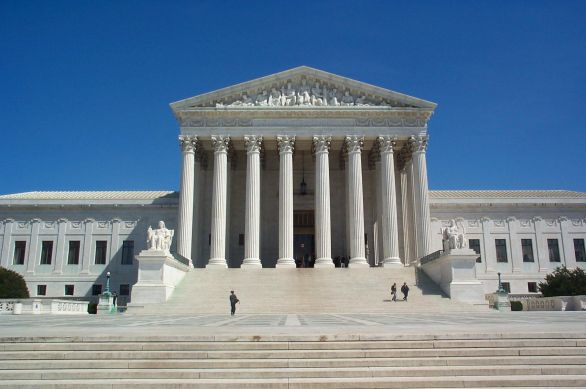Civil Liberties
Related: About this forumYou Canít Protest at the Supreme Court
The Rutherford Institute has filed a federal lawsuit on behalf of a man who was arrested for protesting on the plaza in front of the Supreme Court. All the man did, according to the complaint (and there’s video to support this), is wear a sandwich board with a message on it protesting mistreatment of minorities by the government.
Hodge was charged with violating 40 U.S.C. § 6135, an incredibly broad and clearly unconstitutional regulation prohibiting pretty much any form of protest on the grounds of the Supreme Court, no matter how peaceful it may be.
full: http://freethoughtblogs.com/dispatches/2012/01/27/you-cant-protest-at-the-supreme-court/
sinkingfeeling
(53,020 posts)
gopiscrap
(24,171 posts)laws only apply to progressives, liberals, and Democrats!![]()
jberryhill
(62,444 posts)Pearson v. U.S., 581 A.2d 347 (D.C. 1990), the police set up barricades in front of the Plaza, clearly demarking for anti-abortion demonstrators where lawful demonstrations could take place;
United States v. Wall, 521 A.2d 1140 (D.C. 1987), the police told anti-abortion protestors they would be arrested if they did not return to the sidewalk.
jberryhill
(62,444 posts)They are on the sidewalk.
In fact, if you look closely at that picture, you can SEE two uniformed guards keeping them off the steps and plaza.
Look under the "No More Gore" sign to the left, and then adjacent to it on the right.
sinkingfeeling
(53,020 posts)jberryhill
(62,444 posts)Here is the Plaza:
-----
https://www.rutherford.org/files_images/general/01_24_2012_Complaint_Hodge.pdf
The plaza on which Hodge stood is oval in shape and approximately 252 feet in length. It is separated from the sidewalk between First Street, N.E., and the Supreme Court building grounds by a few small steps which lead up about 3 feet to the plaza. It is a place where the public is allowed to gather and converse and is in all relevant respects like a public square or park, places where citizens have by long-tradition been allowed to meet and express their views on matters of public interest and importance.
----------
If you look at the Google Streetview, you see there are two sets of steps:
http://maps.google.com/maps?q=washington+dc+google+maps&ll=38.89077,-77.005932&spn=0.001049,0.001635&oe=utf-8&client=firefox-a&hnear=Washington,+District+of+Columbia&gl=us&t=h&z=20&layer=c&cbll=38.890662,-77.005931&panoid=wQfa4YiS-tRxhLHNXH5B8g&cbp=12,97.06,,0,0
There are a couple of steps leading up to the plaza, and then another set of steps leading up to the Court entrance.
Looking at the picture above, it is clear that the visible uniformed marshals are standing at an elevation slightly above that of the protesters, but not as high up as the bottoms of the columns.
There's only one way for that to happen, and that is if the marshals are standing at the top of the steps to the Plaza, and the protesters are on the sidewalk area at the bottom of the steps leading up to the Plaza.
What "steps" do you think the marshals are standing on? There are only two sets of steps.
sinkingfeeling
(53,020 posts)
jberryhill
(62,444 posts)The plaza is UP those steps directly in front of them.
Do you see that statue in between the 2nd and 3rd guy from the right?
This is not rocket surgery, look:

There are TWO sets of steps - (1) the steps from the sidewalk to the plaza, and (2) the steps from the plaza to the entrance.
If the people in your picture were standing at the bottom of the second set of steps - i.e. on the plaza - then you wouldn't see that statue between those two guys.
They are standing as close as legally permitted under the statute for the purpose of conducting a protest.
sinkingfeeling
(53,020 posts)jberryhill
(62,444 posts)Hence the marshal with the bullhorn in front of them.
It looks like they are being instructed to leave the steps
jberryhill
(62,444 posts)Last edited Wed Feb 1, 2012, 12:17 PM - Edit history (1)
Is that you probably know that group was indeed arrested for being on those steps:
http://www.abolition.org/jan17/index.html
14 Activists Arrested
at U.S. Supreme Court
to Commemorate 35th Anniversary
of First Execution
updated January 20, 2012
WASHINGTON, D.C. – Thirty-five years after the first execution under contemporary laws of Gary Gilmore, fourteen members of the Abolitionist Action Committee were arrested at the U.S. Supreme Court on Tuesday. Just after 10:00 am, at the exact time that Gilmore was executed, the group unfurled a 30-foot banner that read “STOP EXECUTIONS!” on the stairs of the Court. On the sidewalk, a crowd of well-over 100 supporters, activists and tourists supported and observed the action.
All fourteen were arrested and appeared the following day before a judge for arraignment. They were released on personal recognizance with a charge of violating the federal law (40 U.S.C. 6135) that forbids "processions or assemblages" and the displaying of banners on Supreme Court grounds. A status hearing will take place on February 8th, at which time a trial date will be scheduled.
That's why, in the two other pictures posted of protestors not on the plaza or the steps, they are not facing down a set of marshals clearly fixing to remove them.
Notice that the 100 other observers on the sidewalk were not arrested. That's why they were on the sidewalk. The ones holding the banner intended to be arrested.
jberryhill
(62,444 posts)...but that is another of the Rutherford Institute's projects.
The only reason the Rutherford Institute takes an interest in time, place and manner restrictions is that they want to be able to block abortion clinic doors.
Yes, that's right, you can't protest on the grounds of the Supreme Court. And what would the purpose of that be? To influence the justices? To make sure that a bunch of screaming religious assholes are heard inside the courtroom? To intimidate the parties who are there to have their cases heard?
TheKentuckian
(26,293 posts)At least for government high officials but I'm sure that protection will soon be extended to some of our upstanding "corporate citizens'/"stakeholders" as well.